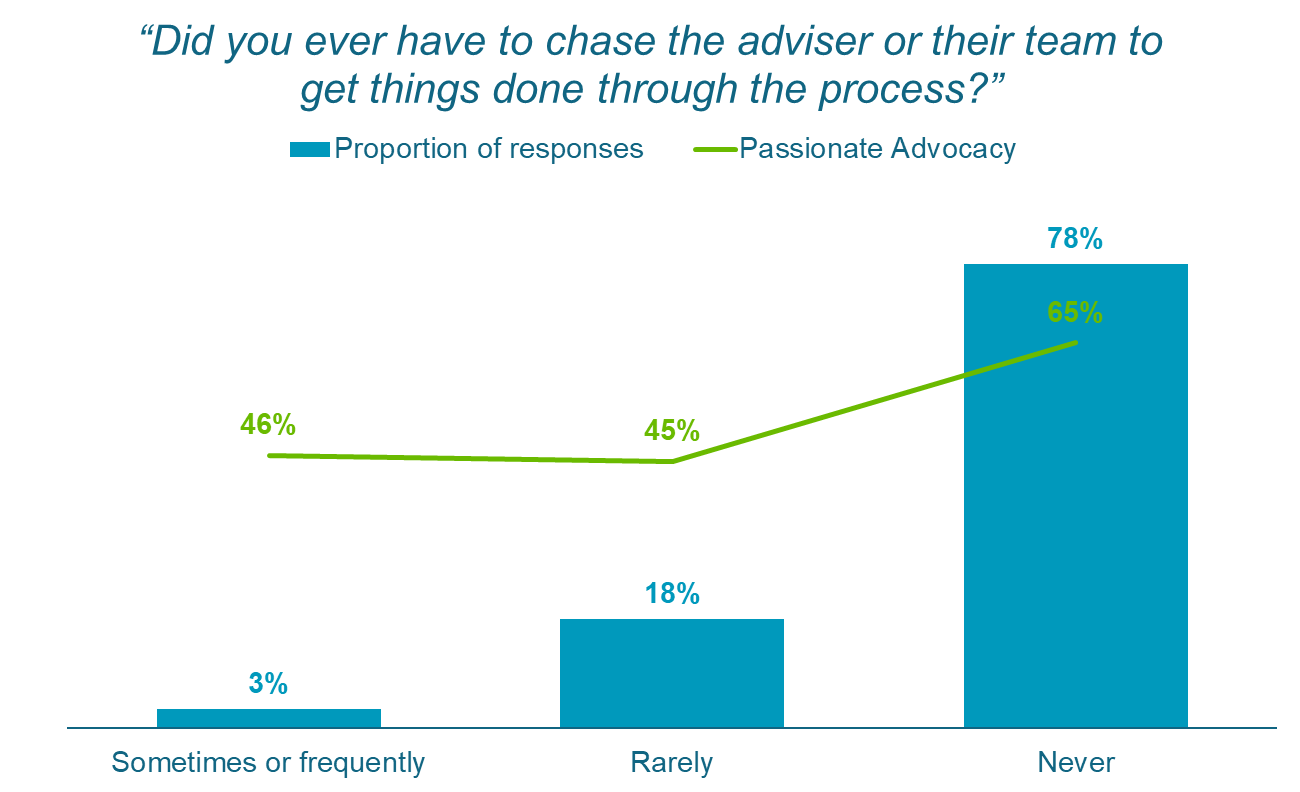Client Never Had To Chase
Client Never Had To Chase is a Driver of Elevation Goal 2: Delighting existing clients, promoting advocacy and retention
Data based on responses to the following question, asked in the Verified Client review form
“Did you ever have to chase the adviser or their team to get things done through the process?”
Possible responses
Never
Rarely
Sometimes
Frequently
Client Never Had To Chase Score
Proportion of respondents answering “Never”
Distribution of responses to Client Never Had To Chase
The relationship between Passionate Advocacy and Client Never Had To Chase is highly statistically significant
Why do we ask about Client Never Had To Chase ?
Speed and efficiency was a key driver of advocacy arising from our qualitative research with advice firms, advisers and clients.
We confirmed this relationship quantitatively through our review forms.
How to improve your score:
Set expectations
Timescales. Ensure you’ve covered the likely timescales of the process with your client.
Anchoring. It’s better to slightly overestimate timelines than to underestimate. Anchoring is a technique where you set an initial expectation, or anchor, as to when something will happen. Once the anchor has been set, your client will judge everything in relation to it.
“The valuation could take up to 2 weeks to complete” – sets the anchor at 2 weeks. If the valuation happens in 5 days, your client will see this as exceeding their expectations and feel good about it."
Don’t over promise. However, be careful setting timescales for others. As the adviser, you are your client’s main point of contact in the process. If someone else is late responding, your client will most likely get in touch with you to chase for an answer.
Acknowledge
Nothing kills passionate advocacy like being ghosted! If your client has left a message for you and not heard back for several days, they’re probably thinking they’re not important to you, and wondering if they made the right choice in coming to you for their mortgage and/or protection policy.
A lack of response to a message will also make your client feel the need to chase you for a response, negatively impacting their experience.
Acknowledge your client’s contact with a quick message or email saying, “I’m in meetings all day today but I’ll call you tomorrow/this evening/next week”. Most client’s will be happy to wait if they know when to expect a call from you. Just make sure you call when you said you would.
Be careful using “out of office” replies because you’re busy. There’s nothing more annoying than getting an “out of office” saying, “We’re busy, so it might be a while before we get back to you”. It’s OK to use an out of office message saying you’re busy, but you MUST say when you’re going to respond and stick to it.
Do what you said, when you said it
Follow through. If you agree to do something at a certain time, do it! By missing your own deadlines, you’ll lower the client’s opinion of you, and they’ll feel they need to chase you for an update.
Buy time. Give yourself more time than you think you’ll need. Things have a habit of coming up and work often takes longer than you think. If you think you’ll have it done by Monday, say Wednesday – that way if the work takes longer than expected and you get it to your client on Tuesday, it will still be early in their eyes!
Communicate changes. If you’re going to miss a deadline, tell your client and when you expect to have it done by. This way they’ll not have to chase to see where things are.
Be proactive
It’s always best to be proactive when providing your client with updates. By contacting them with an update, they’ll not have to call and chase you, which leaves a much better impression and boosts passionate advocacy.
If there’s no update, tell your client there’s no update. A “no-update update” is much better than radio-silence!
Regular updates
Consider sending out regular updates, rather than ad-hoc ones. If your client knows an update is coming in two weeks, they’re much more likely to wait for this rather than call you to chase.
Why not book ½ a day out a week to write out to your clients with updates? Or get an administrator to book out that ½ day. The key is to make client updates a key part of someone’s role within your firm and allocate time to ensure they get done.
Setting expectations, building in leeway, and anchoring helps your client know what to expect. Regular, proactive updates remove the need for your client to chase you and creates the feeling you’re super responsive.

